
Today is November 11, which is Remembrance Day in Canada, and Veterans’ Day in the U.S. (which, thankfully, seems to have survived the midterm elections on Tuesday). Please take a moment to remember the people from all over the world, not just Canada and the U.S., who fought and died, both as soldiers and civilians, to preserve freedom. You and I owe a lot to them, so take a moment next time you see a veteran, to think about what they are and have been willing to sacrifice for your sake.
This week I’m going to write about Robert A. Heinlein, also a WWII veteran (Figure 1), who died in 1988 aged 81. All the time I was growing up, he was the number one SF writer, as far as I (and much of the world) was concerned. I wrote the original version of this column in 2013, after I had made a visit to the little town in Missouri where RAH (as he’s usually known as) was born, but I’ve revised it. Back in 2013, my wife’s parents lived in a “college town” in Missouri called Columbia, and every year (or every other) we drove to and from Columbia to visit. For reasons talked about later in this column, in the summer of 2013 we drove to the town where RAH was born on our way back to Vancouver.
Heinlein was born in a little town in Missouri named Butler. (2012 population is about 4200 people, and it’s about 4 square miles in area.) So you can imagine it was your typical one-horse town in 1907, when Robert Anson Heinlein made his first appearance in the world. (Not that it has a lot more horses now than then.) There are biographies and critiques of his works aplenty (one of the newest is Robert A. Heinlein: In Dialogue with His Century: Volume 1 (1907-1948): Learning Curve by William H. Patterson, Jr. [2010]), so I won’t go into great detail; Heinlein was one of science fiction’s “Big Three”— the other two being Isaac Asimov and Arthur C. Clarke—before sf expanded beyond anyone’s expectations. By the time of Heinlein’s death, he had published over one hundred novels, short stories, and articles. He won six Hugo awards, and had his work adapted into four movies and five television series, according to the Butler Public Library’s website (www.butlerpubliclibrary.org). The Butler Public Library now has a “Robert and Virginia Heinlein” wing, completed in 1991 with funds donated by the Robert and Virginia Heinlein Foundation. (The Butler Public Library has no public funding and must depend on assistance from private sources.)
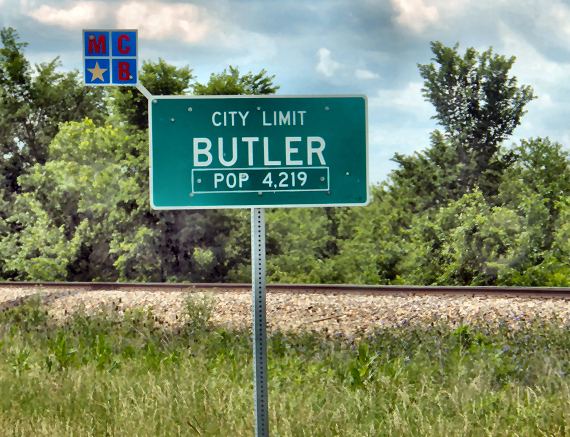
At the time of his death, Heinlein left some notes and ideas for books that he had not yet written, and the Heinlein Society (established with the help of Virginia Heinlein to promote not only the works of RAH, but also to promote science, blood drives—he was a rare blood type and insisted that conventions who hosted him also have a blood drive—and science fiction writing) looked for a writer to carry on his writing; they chose Spider Robinson as the writer who would be the best person to “collaborate” with RAH, and in 2006, Variable Star was published, written by Spider from a 5-page outline left by RAH.
Knowing that I would be driving to Missouri that summer, Spider asked me if I would be going anywhere near Butler and, if so, could I take some photos of the Heinlein wing of the public library. For reasons of my own not related to RAH, I was indeed going to Butler itself (I had bought a ukulele online from a source in Butler, so I decided to save mailing costs and possibly keep postal/shipping services from destroying the instrument en route to me), so I said, “Sure!” and on June 15 of 2013, we drove into the almost prototypical little mid-American town. This town looks like something Ray Bradbury wrote about, with a bandstand on the town square across from the courthouse.
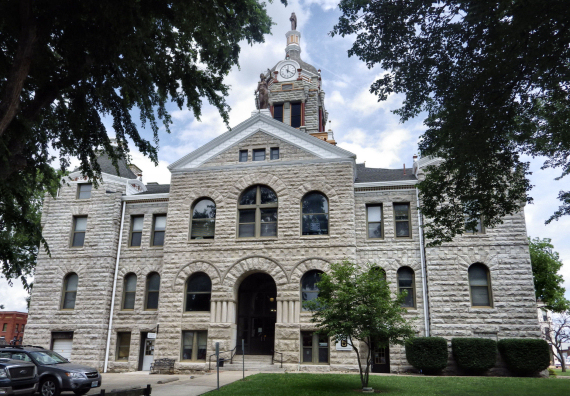
I almost expected to see Mr. Dark and the Dust Witch from Something Wicked This Way Comes! (Or maybe even the story “You Know They Got a Hell of a Band” by Stephen King!)

So after concluding my personal business in the town, I asked for directions to the library. “Sure,” I was told, “You just go a block down this street to the stop sign, turn left, go another block and turn right. You can’t miss it.” So we did, and we did. Hmm. Maybe he meant “turn right and then left,” so we did that. No library. We wound up driving around and around the Town That Time Forgot to the point of frustration; finally, going down a small hill I spied a young man—about 10 or 11 years old—pedaling his bicycle (how small-town can you get?) towards us. I stopped the car and rolled down the window; “Hey, kid—can you tell me how to get to the library?”
“Sure, you just go up to the…” he began, and I interrupted with “I’m a stranger and don’t know any local landmarks.” He thought for a moment, then said, “Aww, it’s complicated. Just follow me!” And he began pedaling up the hill; I made a U-turn and followed him (at about 7 MPH) for the next 15 minutes. Through alleyways, barely pausing at stop signs, and so on—until he triumphantly skidded the wrong way into an “Exit Only” sign at the Butler Public Library! We went around the building and into the proper entry and tipped the kid a dollar!
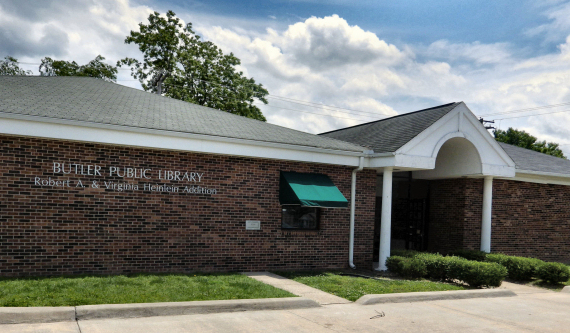
We went in and introduced ourselves to the librarian on duty, who was thrilled that someone would come all the way from Vancouver, BC, to visit their library; she gave us the Grand Tour and told about when RAH had visited Butler; the parade the town had had for them (Robert and Virginia) and many more anecdotes. She was also thrilled that I was a friend of Spider’s and had met Heinlein more than once. Here are some photos of the Heinlein Wing (more of a reading room); I was thrilled to see an older gentleman using the Heinlein Wing to read.

Here’s a photo of the entire Heinlein Wing, plus a photo of the bronze dedication plaque for the wing, which is at the entrance to the library.
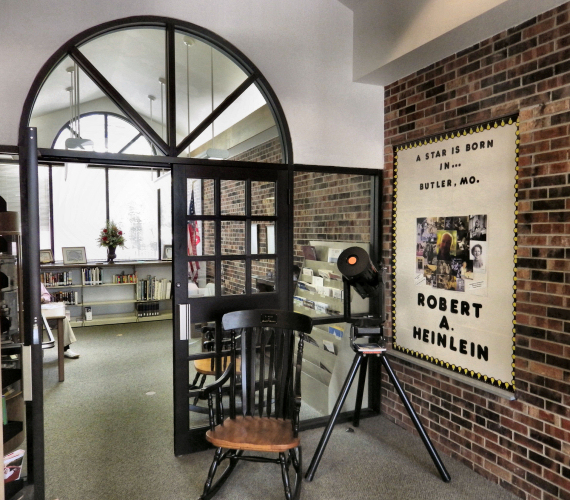
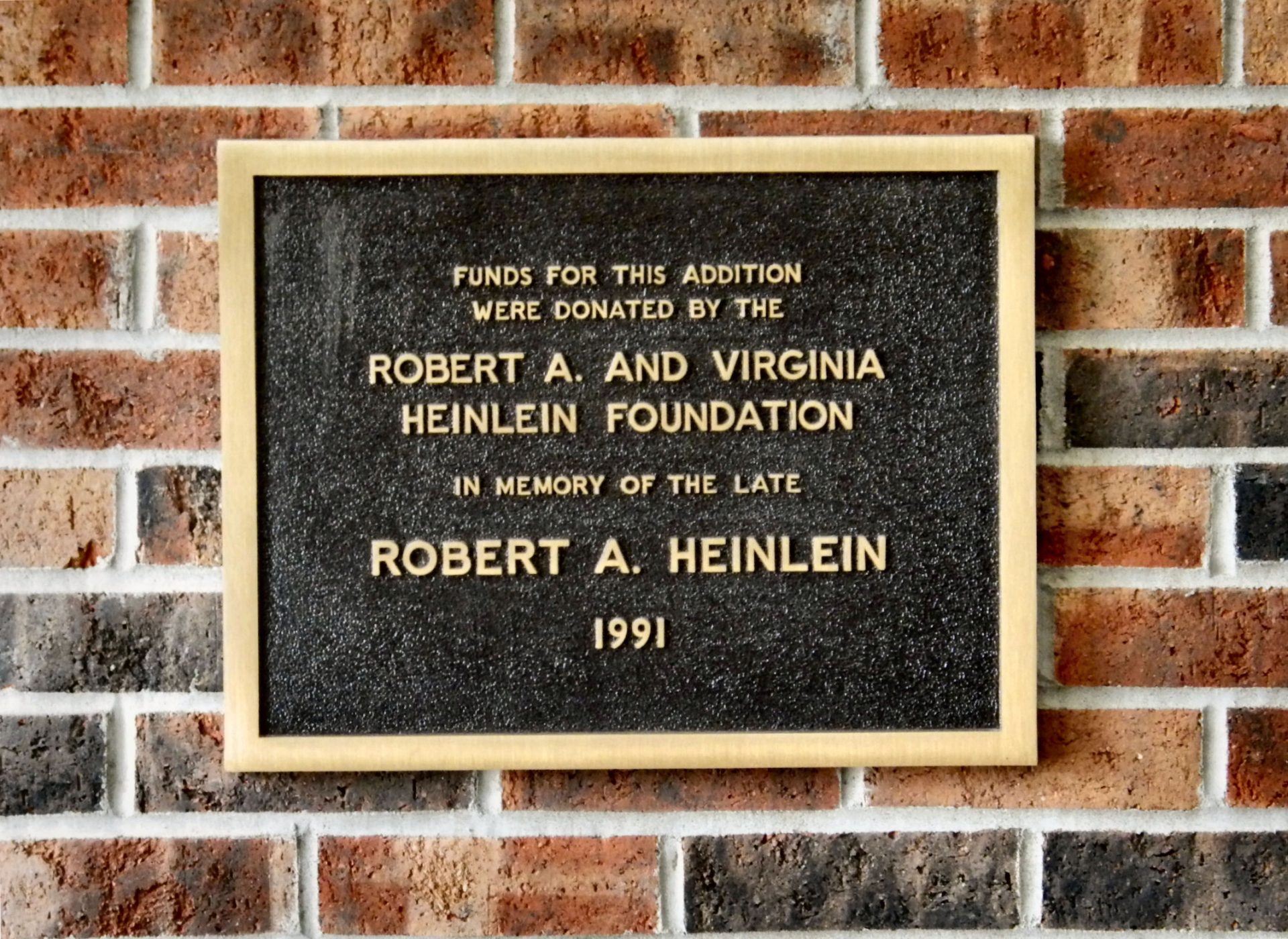
As we were getting into our car after the Heinlein Wing tour, a black pickup pulled up and a woman rushed to stop us leaving; it was the Library Director, Linda Hunter, who’d been informed we were there and who wanted to catch us before we left. After our conversation—repeating a lot of what we’d said and heard inside—we asked her if Heinlein’s birth house was still around. “Oh, yes,” she said, “But the people who own it now really don’t like to be disturbed by Heinlein fans!” It seems that Heinlein fans had been a real pain in the tochus, so Linda was reluctant to give us the address. (We found out later that there were street signs that directed people to the house, so had we searched, we could have found it ourselves.) After promising we’d only look at the outside, she directed us to the old Heinlein house on North Fulton Street. The house itself has a little plaque sitting in a flowerbed.It’s obvious that it once sat in a frame in front of the house, but the present owner moved it (maybe not daring to remove it entirely).

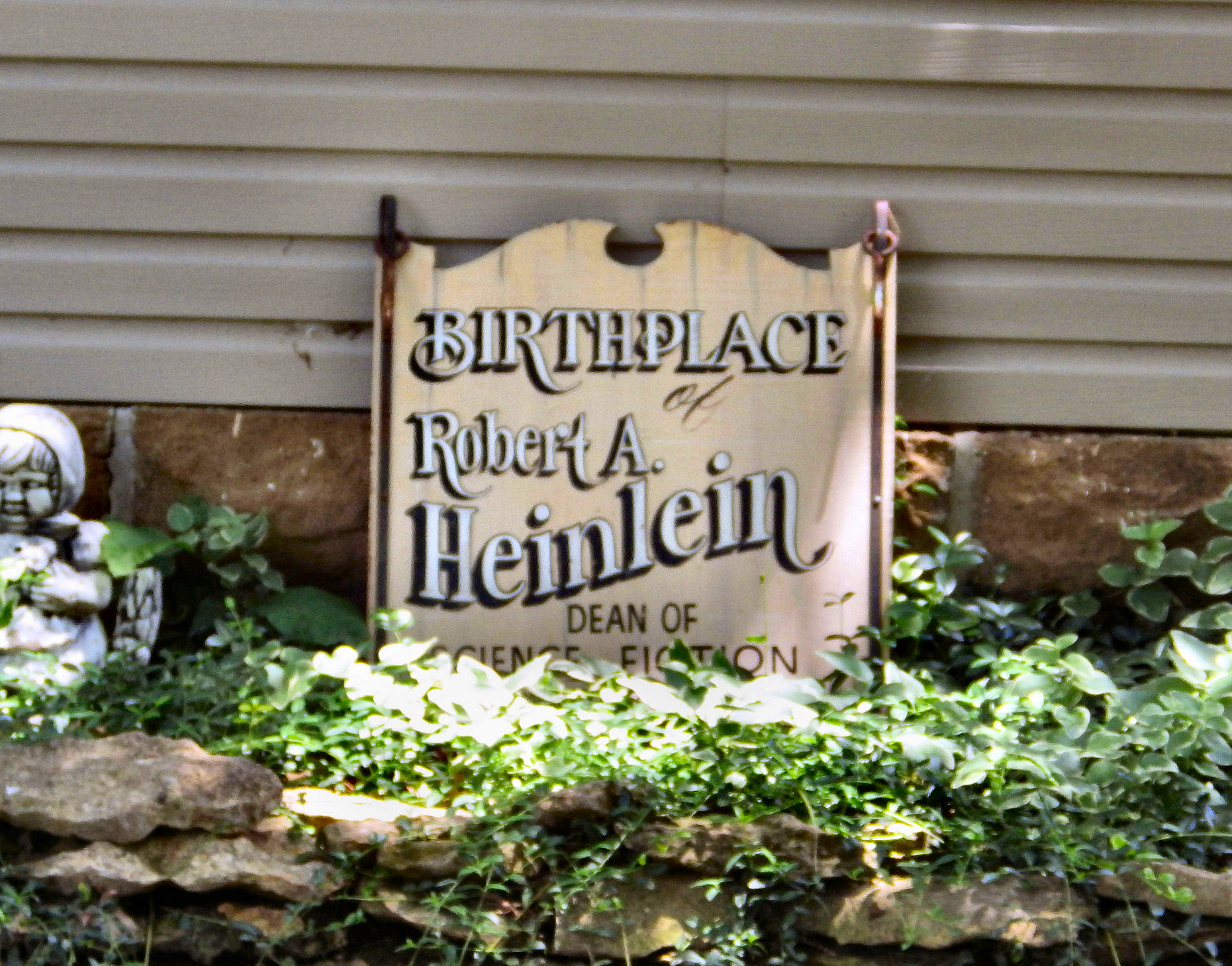
Now, if this had been any other author, I probably wouldn’t have bothered making my one and only “pilgrimage”—but not only have I read everything I can find of Heinlein’s, but I have corresponded with him; I have had books autographed by him (to me) in my library—courtesy of E.E. “Doc” Smith’s daughter, Verna Smith Trestrail—and I have spent a couple of hours talking with both Robert and Virginia Heinlein, thanks to the late artist Frank Kelly Freas, a truly wonderful man. So all sorts of things coincided to bring this about. Would I do it for another author? Isaac Asimov? Ray Bradbury? Arthur C. Clarke? No, probably not. This was a one-off, and I don’t regret it. I’m passionate about science fiction and fantasy, and RAH was a giant influence on both the field and my growing up. I suggest you find your passion—whether in our genre or out of it—and follow yours, too!
Until next time, as Carey Rockwell’s Stand By for Mars (Tom Corbett) book says: “Calling all boys and girls to Mercury, Venus, Jupiter and all points in outer space—You, too, can be a part of the group of daring adventurers from the Space Academy who travel to mysterious lands in outer space on dangerous and exciting missions!” All you have to do is open a book!
If anyone has any comments, you can post them here, or on Facebook, or even by email (stevefah at hotmail dot com). All comments are welcome! (Just be polite, please.) My opinion is, as always, my own, and doesn’t necessarily reflect the views of Amazing Stories or its owner, editor, publisher or other columnists. See you next time!
PUBLISHER’S NOTE: A facsimile of Robert Anson Heinlein, based on television interviews and an animation program, features in Amazing Stories’ latest Kickstarter Project.


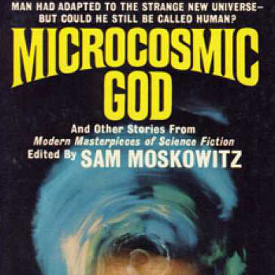








RAH RAH RAH!
wonderful, as always!